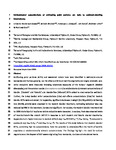Environmental concentrations of antifouling paint particles are toxic to sediment-dwelling invertebrates
| dc.contributor.author | Muller-Karanassos, C | |
| dc.contributor.author | Arundel, W | |
| dc.contributor.author | Lindeque, PK | |
| dc.contributor.author | Vance, T | |
| dc.contributor.author | Turner, Andrew | |
| dc.contributor.author | Cole, M | |
| dc.date.accessioned | 2020-11-20T15:01:39Z | |
| dc.date.issued | 2021-01-01 | |
| dc.identifier.issn | 0269-7491 | |
| dc.identifier.issn | 1873-6424 | |
| dc.identifier.other | 115754 | |
| dc.identifier.uri | http://hdl.handle.net/10026.1/16665 | |
| dc.description.abstract |
Antifouling paint particles (APPs) and associated metals have been identified in sediments around boatyards and marinas globally, but the effects of APPs on benthic organisms are largely unknown. Sub-lethal endpoints were measured following laboratory exposures of the harbour ragworm (Hediste diversicolor) and the common cockle (Cerastoderma edule) to environmentally relevant concentrations of biocidal ('modern' and 'historic') and biocide-free ('silicone') APPs added to clean estuarine sediment. Further, the 5-day median lethal concentrations (LC50) and effects concentrations (EC50) for modern biocidal APPs were calculated. For ragworms, significant decreases in weight (15.7%; p < 0.01) and feeding rate (10.2%; p < 0.05) were observed in the modern biocidal treatment; burrowing behaviour was also reduced by 29% in this treatment, but was not significant. For cockles, the modern biocidal treatment led to 100% mortality of all replicates before endpoints were measured. In cockles, there was elevated levels of metallothionein-like protein (MTLP) in response to both modern and historic biocidal treatments. Ragworms had a higher tolerance to modern APPs (5-day LC50:19.9 APP g L-1; EC50: 14.6 g L-1) compared to cockles (5-day LC50: 2.3 g L-1 and EC50: 1.4 g L-1). The results of this study indicate that modern biocidal APPs, containing high Cu concentrations, have the potential to adversely affect the health of benthic organisms at environmentally relevant concentrations. The findings highlight the need for stricter regulations on the disposal of APP waste originating from boatyards, marinas and abandoned boats. | |
| dc.format.extent | 115754-115754 | |
| dc.format.medium | Print-Electronic | |
| dc.language | en | |
| dc.language.iso | en | |
| dc.publisher | Elsevier | |
| dc.subject | Microplastic | |
| dc.subject | Fouling | |
| dc.subject | Biocidal | |
| dc.subject | Toxicity | |
| dc.subject | Copper | |
| dc.title | Environmental concentrations of antifouling paint particles are toxic to sediment-dwelling invertebrates | |
| dc.type | journal-article | |
| dc.type | Journal Article | |
| plymouth.author-url | https://www.webofscience.com/api/gateway?GWVersion=2&SrcApp=PARTNER_APP&SrcAuth=LinksAMR&KeyUT=WOS:000600553000044&DestLinkType=FullRecord&DestApp=ALL_WOS&UsrCustomerID=11bb513d99f797142bcfeffcc58ea008 | |
| plymouth.issue | Pt A | |
| plymouth.volume | 268 | |
| plymouth.publication-status | Published | |
| plymouth.journal | Environmental Pollution | |
| dc.identifier.doi | 10.1016/j.envpol.2020.115754 | |
| plymouth.organisational-group | /Plymouth | |
| plymouth.organisational-group | /Plymouth/Faculty of Science and Engineering | |
| plymouth.organisational-group | /Plymouth/Faculty of Science and Engineering/School of Geography, Earth and Environmental Sciences | |
| plymouth.organisational-group | /Plymouth/REF 2021 Researchers by UoA | |
| plymouth.organisational-group | /Plymouth/REF 2021 Researchers by UoA/UoA07 Earth Systems and Environmental Sciences | |
| plymouth.organisational-group | /Plymouth/Research Groups | |
| plymouth.organisational-group | /Plymouth/Research Groups/BEACh | |
| plymouth.organisational-group | /Plymouth/Research Groups/Marine Institute | |
| plymouth.organisational-group | /Plymouth/Users by role | |
| plymouth.organisational-group | /Plymouth/Users by role/Academics | |
| dc.publisher.place | England | |
| dcterms.dateAccepted | 2020-09-28 | |
| dc.rights.embargodate | 2021-9-30 | |
| dc.identifier.eissn | 1873-6424 | |
| dc.rights.embargoperiod | Not known | |
| rioxxterms.versionofrecord | 10.1016/j.envpol.2020.115754 | |
| rioxxterms.licenseref.uri | http://www.rioxx.net/licenses/all-rights-reserved | |
| rioxxterms.licenseref.startdate | 2021-01-01 | |
| rioxxterms.type | Journal Article/Review |


